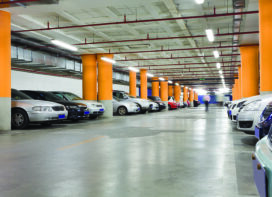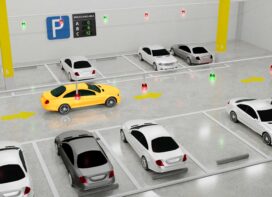 As vehicle numbers soar unabated in Indian cities, once peaceful residential areas are becoming battlegrounds for parking, with residents also battling outsiders who usurp local parking. Ranjit Gadgil, Programme Director, Parisar, looks at how Residential Parking Permits offer a way out for tackling this problem.
As vehicle numbers soar unabated in Indian cities, once peaceful residential areas are becoming battlegrounds for parking, with residents also battling outsiders who usurp local parking. Ranjit Gadgil, Programme Director, Parisar, looks at how Residential Parking Permits offer a way out for tackling this problem.
 The principles of sustainable urban transport stress the need for cities that promote public and non-motorised transport (walking and cycling) and wean people away from using their personal modes such as two-wheelers and cars. They further advocate compact cities with mixed use, so that people are able to access work, education and services without travelling large distances. Integration of all modes of travel makes it convenient for people to use a combination of walking, cycling and public transport to get to their destinations. This is essential if people are to prefer these sustainable modes in lieu of their own vehicles.
The principles of sustainable urban transport stress the need for cities that promote public and non-motorised transport (walking and cycling) and wean people away from using their personal modes such as two-wheelers and cars. They further advocate compact cities with mixed use, so that people are able to access work, education and services without travelling large distances. Integration of all modes of travel makes it convenient for people to use a combination of walking, cycling and public transport to get to their destinations. This is essential if people are to prefer these sustainable modes in lieu of their own vehicles.
Parking of personal vehicles must be seen in this context. Rather than creating more and more parking to accommodate ever increasing number of vehicles, parking needs to be used as a tool for ?Transport Demand Management? (TDM). TDM can disincentivise the use of personal vehicles to tilt the balance in favour of public and non-motorised modes. There are several strategies that can be adopted with regards to parking, such as maximum parking norms (instead of minimum parking norms) for buildings, removal of or restrictions on on-street parking (No Parking, P1/P2 parking, time limits on parking etc) and making parking charges commensurate with either the value of the land it occupies (higher charges in core city areas and prime areas) or based on the demand-supply equation (higher rates when demand for parking is high, such as peak hours in shopping districts).
Another key aspect of parking management involves local area parking, that is parking in predominantly residential areas, used mainly by local residents, but which is often used by visitors to that locality.
How Local Area Parking works today?
 On-street parking restrictions typically apply to major thoroughfares (arterial and sub-arterial roads), where traffic police and civic authorities strive to improve the flow of traffic by strictly controlling parking. Smaller roads and lanes, especially in residential areas (but which may have a fair amount of non-residential uses) are not so carefully administered. In the past, local residents were usually able to find parking for their own vehicles, as many buildings didn?t have internal parking facilities. With time, even with increasing building parking requirements, the demands on local parking have increased due to densification of neighbourhoods (bungalows becoming apartments), higher vehicle ownership, visitation to these areas, increase in non-residential activities (such as small offices, classes etc) and spill-over from neighbouring roads. Traditionally quiet neighbourhoods have become increasingly choked with parked vehicles, often encroaching upon footpaths and other public spaces deteriorating the quality of life in these areas and leading to conflicts. Residents are known to fight (sometimes escalating into serious physical altercations) with one another and outsiders, corral certain spots for themselves or even barricade entrances to the whole lane/area (even though these are public streets).
On-street parking restrictions typically apply to major thoroughfares (arterial and sub-arterial roads), where traffic police and civic authorities strive to improve the flow of traffic by strictly controlling parking. Smaller roads and lanes, especially in residential areas (but which may have a fair amount of non-residential uses) are not so carefully administered. In the past, local residents were usually able to find parking for their own vehicles, as many buildings didn?t have internal parking facilities. With time, even with increasing building parking requirements, the demands on local parking have increased due to densification of neighbourhoods (bungalows becoming apartments), higher vehicle ownership, visitation to these areas, increase in non-residential activities (such as small offices, classes etc) and spill-over from neighbouring roads. Traditionally quiet neighbourhoods have become increasingly choked with parked vehicles, often encroaching upon footpaths and other public spaces deteriorating the quality of life in these areas and leading to conflicts. Residents are known to fight (sometimes escalating into serious physical altercations) with one another and outsiders, corral certain spots for themselves or even barricade entrances to the whole lane/area (even though these are public streets).
Why increasing parking requirement is not a good solution?
The typical policy reaction to this situation is to increase minimum parking norms for buildings; that is to require greater provision of parking within buildings per tenement, so that more vehicles can be accommodated inside the building. Visitor parking is also made mandatory. These are usually implemented by way of ?Development Control? (DC) Rules of the city. There are however limitations to this approach and inherent contradictions with sustainable transport policies.
There are broadly three reasons why increasing parking requirements is not desirable. Firstly, any increase in parking spaces makes housing more expensive. Secondly it is unfair to those who wish to avoid having personal vehicles, since whether or not they own a second car (for instance), they would still have to buy the extra parking space. Lastly, and perhaps most importantly, the increase in parking spaces simply creates an indirect incentive for people to own more vehicles and consequently use them. Increasing parking spaces in buildings also at best solves part of the problem, since each vehicle typically requires three parking spaces in the city ? home, work and other (market/street/theatre/restaurant etc).
Managing Street Parking
The standard solution is to charge for on-street parking at rates that reflect the demand for parking in that area or that time of the day. A general rule of thumb used in the West is to charge at a rate that ensures ~85% occupancy; any less and parking becomes full which leads people to either cruise for parking or resort to double parking. Any more and the parking becomes empty and space is wasted. On-street parking is also typically for a short duration, with maximum upper time limits. Longer duration parking should happen in off-street parking lots, which should be privately run ? they should not be subsidised by public money. On-street parking should be always more expensive than off-street parking, reflecting the fact that it is more convenient.
Residential Parking
 Charging for on-street parking in residential areas presents another challenge. While keeping the principle of charging for parking, one has to accommodate the needs of local residents also. This leads us to the idea of ?Residential Parking Permits?. The basic idea is to give local residents ?zonal permits? and designate the ?zones? on the local streets. Only those in possession of a permit are allowed to park on certain streets at certain times. These streets are thus reserved for the special permit holders. Permits are given only to local residents, who must display the permit in their cars or affix them to their two-wheelers. Streets are clearly marked, indicating the zone and also specifying the time when the zonal restrictions are in force.
Charging for on-street parking in residential areas presents another challenge. While keeping the principle of charging for parking, one has to accommodate the needs of local residents also. This leads us to the idea of ?Residential Parking Permits?. The basic idea is to give local residents ?zonal permits? and designate the ?zones? on the local streets. Only those in possession of a permit are allowed to park on certain streets at certain times. These streets are thus reserved for the special permit holders. Permits are given only to local residents, who must display the permit in their cars or affix them to their two-wheelers. Streets are clearly marked, indicating the zone and also specifying the time when the zonal restrictions are in force.
The zonal restrictions are time limited, since typically during the day (say 9:00 am ? 5:00 pm), local residents do not require on-street parking and the spaces can be used by outsiders.
Such schemes first came about in the 70s in the U.S and Canada and are now widespread in many residential areas.
Benefits of Residential Parking Permits
 Quite obviously, local residents benefit from Residential Parking Permits since they are assured parking spaces on streets in their neighbourhood and protected from these spaces being usurped by outsiders, especially during the time they require it (5:00 pm ? 9:00 am). This does however come at a cost ? parking that used to be free is now required to be purchased. This also leads to a more equitable sharing of local area parking. An individual with several cars will no longer be able to hijack all the parking in the neighbourhood, since typically each property will be given only a fixed (usually one or two) residential parking permits. Another indirect advantage is that those who do not own vehicles and hence make no claims on the parking in the local area will not purchase a permit and thus save money. It thus becomes an incentive not to own a personal vehicle.
Quite obviously, local residents benefit from Residential Parking Permits since they are assured parking spaces on streets in their neighbourhood and protected from these spaces being usurped by outsiders, especially during the time they require it (5:00 pm ? 9:00 am). This does however come at a cost ? parking that used to be free is now required to be purchased. This also leads to a more equitable sharing of local area parking. An individual with several cars will no longer be able to hijack all the parking in the neighbourhood, since typically each property will be given only a fixed (usually one or two) residential parking permits. Another indirect advantage is that those who do not own vehicles and hence make no claims on the parking in the local area will not purchase a permit and thus save money. It thus becomes an incentive not to own a personal vehicle.
The local area/mohalla/prabhag also can benefit from the money collected from the sale of these permits and can be used for local area improvements such as benches, street lighting, landscaping and any other demands that local citizens might have.
There is simply no alternative to managing street parking in a way that is both fair to motorists and other non-motorised users of the street and which broadly discourages the use, if not ownership, of two-wheelers and cars.
 TrafficInfraTech Magazine Linking People Places & Progress
TrafficInfraTech Magazine Linking People Places & Progress


